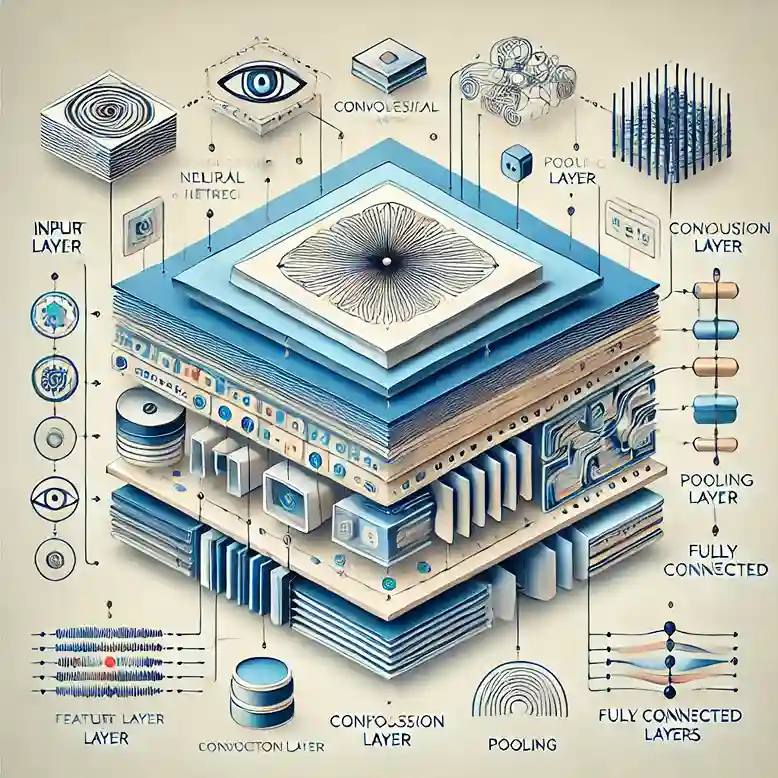Blogs / Convolutional Neural Networks (CNN): Architecture, Applications, and Significance in Deep Learning
Convolutional Neural Networks (CNN): Architecture, Applications, and Significance in Deep Learning

Introduction
Convolutional Neural Networks (CNNs) are among the most important and advanced deep learning tools designed for processing and analyzing multi-dimensional data such as images, videos, and 3D data. Due to their special structure and ability to extract complex features, these models have gained a unique position in areas like computer vision and image processing.
In this article, we will explore the principles of CNNs, their structure, advantages and disadvantages, and diverse real-world applications.
CNN Architecture
CNNs are designed to process inputs—typically images—in a way that effectively extracts important features. The architecture of a CNN consists of several layers, each performing specific tasks.
1. Convolution Layer
This is the core of a CNN. By applying convolutional filters (kernels) over the input, it extracts important features. Each kernel slides across the image to produce a feature map, enabling the model to detect edges, patterns, and shapes.
2. Pooling Layer
The pooling layer reduces the size of feature maps, lowering computational complexity and improving efficiency. Common types are Max Pooling—selecting the maximum value in a region—and Average Pooling—computing the average value.
3. Activation Layer
Activation layers apply non-linear functions like ReLU (Rectified Linear Unit) to feature maps, allowing the model to learn non-linear relationships between data.
4. Fully Connected Layer
These layers operate like traditional neural networks, using the features extracted by previous layers for prediction or classification tasks.
5. Dropout Layer
To prevent overfitting, dropout layers randomly deactivate a subset of neurons during training, forcing the model to generalize rather than memorize the training data.
Advantages of CNNs
1. Efficient Image Processing
CNNs are optimized for image data and can efficiently identify and analyze complex visual features.
2. Reduced Parameters
Compared to traditional neural networks, CNNs use fewer parameters due to convolution and pooling layers, resulting in faster training and lower memory usage.
3. Automatic Feature Learning
Unlike traditional methods requiring manual feature extraction, CNNs automatically learn features, making them highly effective for complex data-processing tasks.
4. High Generalization
Thanks to their flexible architecture, CNNs generalize well and can be applied to diverse applications.
Applications of CNNs
CNNs are used widely across various fields and play a key role in technology advances. Below are some primary applications.
1. Image Recognition and Classification
CNNs are extensively used in image recognition and classification. They can detect objects in images and categorize them into classes—such as identifying animals, vehicles, or products.
2. Computer Vision
In computer vision, CNNs power applications like facial recognition, motion detection, and object tracking—critical for surveillance and security systems.
3. Video Processing
CNNs analyze video content; for example, in smart surveillance, they detect suspicious movements and trigger alerts.
4. Natural Language Processing (NLP)
Although primarily for image data, CNNs also contribute to NLP tasks—such as text analysis and sentiment detection—by extracting useful features from textual data.
5. Medical Imaging
In healthcare, CNNs analyze medical images—X-rays, MRIs, and CT scans—to aid in diagnosing diseases like cancer and cardiac conditions.
6. Autonomous Vehicles
CNNs form the core of perception systems in self-driving cars, identifying traffic signs, obstacles, and lane markings.
Challenges and Limitations of CNNs
Despite their advantages, CNNs face challenges and limitations.
1. Large Data Requirements
Training CNNs requires substantial labeled datasets; insufficient data can severely degrade performance.
2. Computational Complexity
CNNs’ complex architecture and high volume of convolution operations demand significant computational resources, posing challenges in resource-constrained environments.
3. Sensitivity to Input Variations
CNNs can be sensitive to small input changes—like rotation or lighting variations—potentially reducing accuracy if not properly addressed.
4. Hyperparameter Tuning
Achieving optimal performance requires careful tuning of CNN hyperparameters, a time-consuming and complex process.
Conclusion
Convolutional Neural Networks (CNNs) are pivotal deep learning tools for multi-dimensional data analysis. Their advanced architecture and feature extraction capabilities make them ideal for tasks like image recognition, video processing, and computer vision.
While CNNs face challenges such as large data needs and computational demands, ongoing advances in hardware and algorithms are improving their efficiency. As CNN usage expands across domains, they will continue to drive progress in artificial intelligence.
✨
With DeepFa, AI is in your hands!!
🚀Welcome to DeepFa, where innovation and AI come together to transform the world of creativity and productivity!
- 🔥 Advanced language models: Leverage powerful models like Dalle, Stable Diffusion, Gemini 2.5 Pro, Claude 4.5, GPT-5, and more to create incredible content that captivates everyone.
- 🔥 Text-to-speech and vice versa: With our advanced technologies, easily convert your texts to speech or generate accurate and professional texts from speech.
- 🔥 Content creation and editing: Use our tools to create stunning texts, images, and videos, and craft content that stays memorable.
- 🔥 Data analysis and enterprise solutions: With our API platform, easily analyze complex data and implement key optimizations for your business.
✨ Enter a new world of possibilities with DeepFa! To explore our advanced services and tools, visit our website and take a step forward:
Explore Our ServicesDeepFa is with you to unleash your creativity to the fullest and elevate productivity to a new level using advanced AI tools. Now is the time to build the future together!